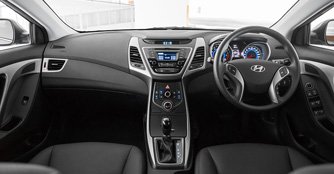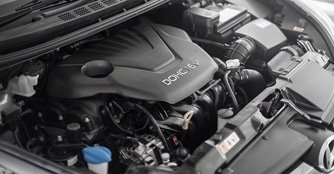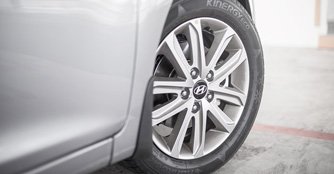Hyundai Elantra 1.6 Elite (A) Facelift Review
11 Apr 2014|64,628 views
Introduced in 1990, the Elantra was a global best seller for Korean marque Hyundai, especially with the fourth generation, called the Avante in Singapore, that was launched in 2006.
Now in its fifth generation, Hyundai has given the Elantra an update with minor styling flourishes and some changes to the level of equipment offered.
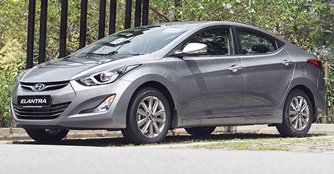
Up close and Personal
It's a relatively mild rework to the Elantra from the outside. What's new is a pair of square-bezel HID projection headlights, a slightly revised chrome grille, a new front bumper which houses redesigned foglights, a new chrome belt line as well as a black rear diffuser.
All these styling changes serve to enhance an already accomplished car in the aesthetic department.
Interior changes are slightly more extensive, with the focus around the centre console.
Materials used have undergone some plastic surgery with stainless steel trim replacing the chrome one on the outgoing model and a simplified gear lever.
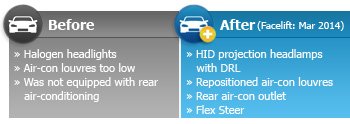 |
Addressing criticism it received from the outgoing model, Hyundai raised the previously too-low mounted central air vents to face level height, flanking either side of a revamped multimedia system.
Not forgetting passengers at the back, a new rear air-con outlet has also been added, which is a nice feature to have, taking into account the hot and humid climate on our sunny island.
Other than that though, it is pretty much the same interior as before. Decent head and legroom is available with a sizeable 421 litres of cargo space that is sufficient for groceries or occasional luggage.
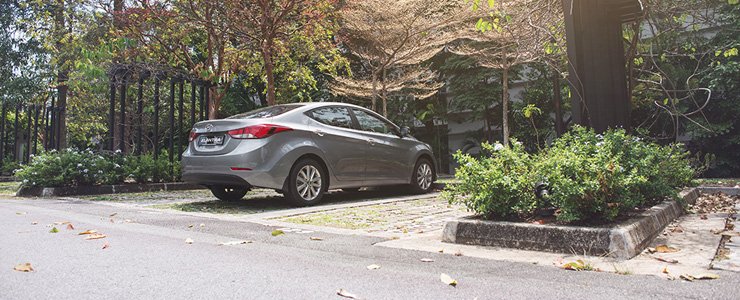 |
The Drive
The Elantra is powered by the same 1.6-litre Dual-CVVT engine as before. The four-cylinder power unit is adequately powered for most situations but needs a little bit of coaxing if there is a need to hustle into a line of fast-moving traffic or to overtake quickly.
The gearbox has a part to play in this as well and it remains unchanged for the update.
Working well with the engine, the six-speed automatic transmission provides decent response, though we wouldn't mind snappier changes when swapping cogs manually.
In terms of fuel efficiency, the Elantra also fared well, returning a commendable 12.4km/L with peak hour traffic and a driver in a rush for time.
The fact that the Elantra continues to handle well comes across as an added advantage.
The sedan feels nimble on the road, carving through corners with unexpected grace and while the Elantra is no bush-basher, it soaked up bumps and ruts without much fuss.
The car also retains the same positive steering that's happy to change direction, and good feedback that we previously admired.
This has been further enhanced with the inclusion of Flex Steer that offers three levels of power assistance - Comfort, Normal and Sport - depending on the driver's preference.
Conclusion
Hyundai did not bother doing too much to the Elantra for this update and that's probably because it didn't require a great deal of improvement to begin with.
Nonetheless, the updates made to the Elantra are more than welcome. Thanks to a fatter equipment list, the car's bound to find more interest among buyers shopping for a mid-size sedan.
Introduced in 1990, the Elantra was a global best seller for Korean marque Hyundai, especially with the fourth generation, called the Avante in Singapore, that was launched in 2006.
Now in its fifth generation, Hyundai has given the Elantra an update with minor styling flourishes and some changes to the level of equipment offered.
Up close and Personal
It's a relatively mild rework to the Elantra from the outside. What's new is a pair of square-bezel HID projection headlights, a slightly revised chrome grille, a new front bumper which houses redesigned foglights, a new chrome belt line as well as a black rear diffuser.
All these styling changes serve to enhance an already accomplished car in the aesthetic department.
Interior changes are slightly more extensive, with the focus around the centre console.
Materials used have undergone some plastic surgery with stainless steel trim replacing the chrome one on the outgoing model and a simplified gear lever.
Addressing criticism it received from the outgoing model, Hyundai raised the previously too-low mounted central air vents to face level height, flanking either side of a revamped multimedia system.
Not forgetting passengers at the back, a new rear air-con outlet has also been added, which is a nice feature to have, taking into account the hot and humid climate on our sunny island.
Other than that though, it is pretty much the same interior as before. Decent head and legroom is available with a sizeable 421 litres of cargo space that is sufficient for groceries or occasional luggage.
The Drive
The Elantra is powered by the same 1.6-litre Dual-CVVT engine as before. The four-cylinder power unit is adequately powered for most situations but needs a little bit of coaxing if there is a need to hustle into a line of fast-moving traffic or to overtake quickly.
The gearbox has a part to play in this as well and it remains unchanged for the update.
Working well with the engine, the six-speed automatic transmission provides decent response, though we wouldn't mind snappier changes when swapping cogs manually.
In terms of fuel efficiency, the Elantra also fared well, returning a commendable 12.4km/L with peak hour traffic and a driver in a rush for time.
The fact that the Elantra continues to handle well comes across as an added advantage.
The sedan feels nimble on the road, carving through corners with unexpected grace and while the Elantra is no bush-basher, it soaked up bumps and ruts without much fuss.
The Elantra is powered by the same 1.6-litre Dual-CVVT engine as before. The four-cylinder power unit is adequately powered for most situations but needs a little bit of coaxing if there is a need to hustle into a line of fast-moving traffic or to overtake quickly.
The gearbox has a part to play in this as well and it remains unchanged for the update.
Working well with the engine, the six-speed automatic transmission provides decent response, though we wouldn't mind snappier changes when swapping cogs manually.
In terms of fuel efficiency, the Elantra also fared well, returning a commendable 12.4km/L with peak hour traffic and a driver in a rush for time.
The fact that the Elantra continues to handle well comes across as an added advantage.
The sedan feels nimble on the road, carving through corners with unexpected grace and while the Elantra is no bush-basher, it soaked up bumps and ruts without much fuss.
The car also retains the same positive steering that's happy to change direction, and good feedback that we previously admired.
This has been further enhanced with the inclusion of Flex Steer that offers three levels of power assistance - Comfort, Normal and Sport - depending on the driver's preference.
Conclusion
Hyundai did not bother doing too much to the Elantra for this update and that's probably because it didn't require a great deal of improvement to begin with.
Nonetheless, the updates made to the Elantra are more than welcome. Thanks to a fatter equipment list, the car's bound to find more interest among buyers shopping for a mid-size sedan.
Car Information
Hyundai Elantra 1.6 Elite (A)
CAT A|Petrol|14.9km/L
Horsepower
97kW (130 bhp)
Torque
157 Nm
Acceleration
11.6sec (0-100km /hr)
This model is no longer being sold by local distributor
All Used Hyundai ElantraThank You For Your Subscription.




















